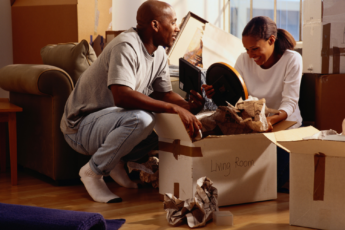Packing up an entire home you’ve lived in for a number of years can feel impossible at first. However, there are some packing tips and tricks that you can use to help make your move seamless. Many people don’t know the right way to approach packing, so they end up accidentally wasting time, being forced to repack certain areas, or facing unnecessary challenges. By following the below advice from experts, you can move with ease.
Gather Packing Supplies First
Moving will bring about more trips to your local hardware store than you thought possible if you let it. It’s easy to find yourself running back and forth in an attempt to patch holes before your move, gather moving supplies, and more. If you take the time to sit down with a list of items you’ll need for the move, you can get everything you need in one trip instead of 10. Here’s what we recommend:
-
Small boxes
-
Medium boxes
-
Large boxes
-
Garment Bags
-
Packing Tape
-
Bubble Wrap
-
Markers
-
Box Labels
Donate, Donate, Donate
Before you start meticulously placing your belongings in boxes, do a sweep of your entire home to see what you can donate or otherwise get rid of. It makes no sense to spend time and energy packing things that you don’t use or need anymore. There’s no better time to declutter your house than when you have to move anyway, so invest a few days into getting rid of the items that shouldn’t be coming with you in your new chapter.
Start Packing Rooms You Don’t Use
Packing early is always the best approach, but you don’t want to pack everything too early, leaving you and your family struggling to get by without your basic necessities. By starting with the garage, guest bedroom, and basement, you can get a lot of items checked off your to-do list without putting a strain on your day-to-day. After you’ve packed all the rooms you don’t frequent, begin tackling bedrooms and other rooms by packing up extra bedding, winter clothes, big kitchen dishes, and more.
Put Heavier Items on the Bottom
Heavy items should go on the bottom when packing boxes. Not only is it unfortunate for your heavy belongs to crush the lightweight items beneath them, but putting the heavy items on top will make it harder to lift and carry the boxes during the move. Don’t put too many heavy items in one box; try to keep each box no more than 30 lbs. to avoid moving injuries, damaged belongings, or breaking a box and being forced to repack it.
Wrap Fragile Items
If people are only moving a short distance, it’s not uncommon for them to think they don’t need to wrap their fragile items. This is a huge mistake because your favorite items can get damaged in a matter of minutes, even if the trip is short. Taking the time to wrap and properly pack your fragile items will save you the headache of cleaning up broken glass, replacing your prized possessions, and dealing with the sadness of something breaking. It may feel tedious and time-consuming, but it’s worth it.
Pack Room-by-Room
As much as you can, try to tackle one room at a time. This approach will help you feel a sense of accomplishment throughout the moving process and make it easier to keep everything organized. The caveat to this is that some of the final days of the move may require you to pack by category and leave essential items unpacked until the very last minute.
Label Each Box
It doesn’t have to be fancy; you can literally take a permanent marker and write the room on each box. This offers a key to anyone helping you move, whether it’s a team of movers or a group of friends, on where to put each box in the new house, making the unpacking process as easy as possible. If there are fragile items in a box, be sure to label it “fragile” as well. Moving can be rough on your belongings but letting people know that they need to handle certain boxes with care will cut down on accidental damages during the process.
Disassemble Furniture
It might feel like a pain but packing a moving truck will be much more efficient with disassembled furniture. Yes, that means you’ll need to take apart your bed frames and unscrew the legs from your table, but if you don’t, you probably won’t be able to fit everything in one truck.
Packing the Truck: Heavy and Large Items Go First
Similar to packing your boxes, you’re going to want to put the heaviest items in the truck first. We recommend putting larger furniture items towards to front of the truck, then packing boxes after that. The higher you start to stack things, the lighter you will need to ensure each box is. Keeping the weight as evenly distributed as possible will keep things from falling as you drive and give the driver more control on the road.
Secure Belongings with Moving Straps
If you’re worried about anything falling over or getting out of place in transport, moving straps will be your best friend. Taking a few minutes to secure bulky furniture items, breakable mirrors, or more will be well worth it. Try strapping one section at a time. For instance, load heavy items near the cab and on the bottom of the truck, then strap those items down before adding medium-weight boxes on top. Strap the medium-weight section down before adding the lightest boxes on the very top.
Slow and Steady Wins the Race
Using a specific methodology for moving is about more than just an easy experience, it’s also about safety. During your move, you will be placing a lot of physical stress on your body but conducting a proper move can help protect you from any injuries. It’s important that you and all your belongings make it to your new home in one piece. Follow the above tips to ensure it all goes well.






Leave a Comment